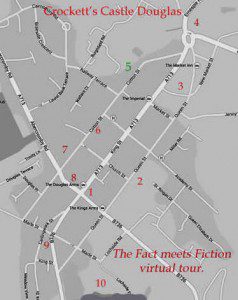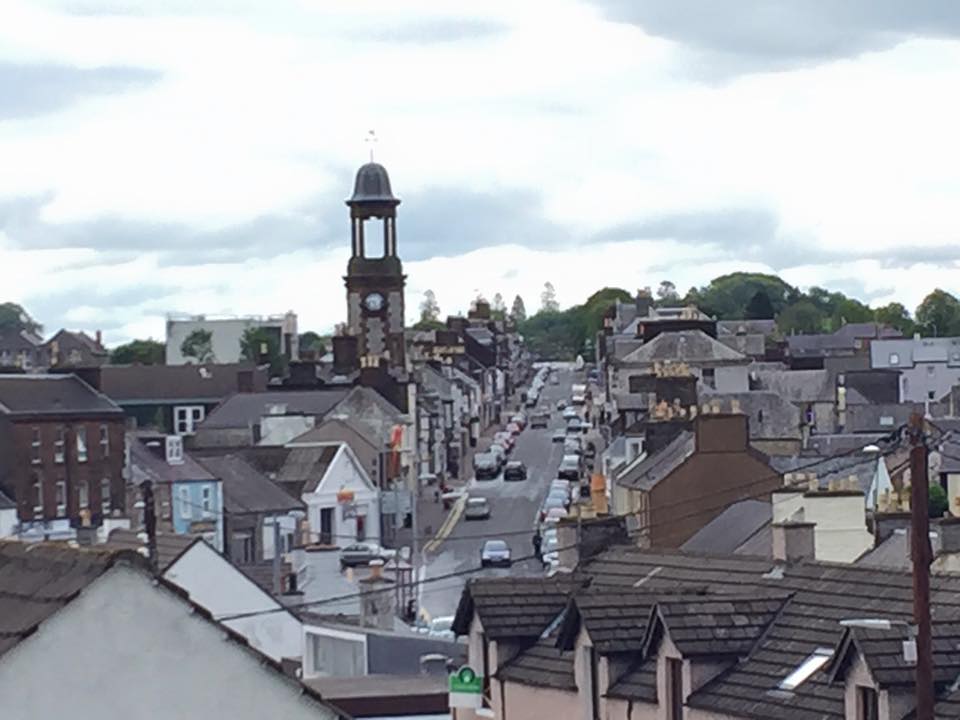‘Little town, once built at the foot of a hill and ever since running a race up it—I do not know whether you are very proud of me, but at any rate I am proud of you.’ (S.R.Crockett ‘Raiderland’ 1904)
All right minded people know that Castle Douglas Civic week is held in July, culminating in Douglas Day (this year on Saturday 25th). Fewer people know the depth of connection between S.R.Crockett and Castle Douglas. Perhaps this is because he refers to Castle Douglas in his fiction as ‘Cairn Edward.’ It certainly seems odd that such a prolific writer and prominent figure should not be commemorated in his own home town.

[picture Fact Meets Fiction tour map]
The Galloway Raiders have set up a ‘virtual’ fact meets fiction tour (pending someone seeing sense and producing the funding to make it a ‘real’ tour) which you can take through July direct from the Raiders site. A ten part journey, it takes in all the Crockett related places in CD from his birthplace in Cotton Street, to Cowper’s school and features the Cross, the Kirk on the Hill, the Railway, The Mart, The Mechanics Institute as well as exploring the Mystery of the Mills before heading down to ‘Little Dublin’ and Carlingwark Loch. There are links to readings and images which will give you a sense of CD as it was in Crockett’s day. If you live in CD it might open your eyes to the ‘fiction’ and history of your town. And if you don’t live in or near CD, it’s a great way to visit.
I first ‘met’ Crockett in CD library but it amazes me how few people locally are aware of the number of his stories that are set in and around the town. For example ‘The Cairn Edward Kirk Militant’ takes you on a trip down King Street. You can listen to this story by going to the Galloway Raiders Website and clicking on Cairn Edward. The Douglas Arms and The Crown both feature in Crockett novels and his non-fiction work ‘Raiderland’ from 1904 has two chapters on Castle Douglas which are interesting and informative for anyone keen to know more of the history of the town. He writes:
‘Castle-Douglas, which I knew as a village, has grown into the ‘emporium’ from which the most part of Galloway supplies itself. Its position makes it a natural centre for the traveller. It has the advantages, as well as the disadvantages of prosperity. It is neat, clean—a proper town, in every sense. The houses wear a smiling aspect. They know that they are well built and able to bring in good money to the fortunate owners. The shops, though noways garish, have the look of steady-paying customers and excellent connections. The churches are large, well filled, well manned, advancing, zealous in all good works, and, as of old—well able to speak out their opinions of each other.’

[picture, Railway]
Crockett’s fiction is also a great place to find out how CD was, especially in the 19th century, so reading his novels and short stories can be a great way to discover local social history. Cairn Edward features in ‘A Galloway Herd’ , ‘Kit Kennedy’, ‘The Stickit Minister,’ ‘The Stickit Minister’s Wooing’ and ‘The Bloom o’ the Heather’ among others of the 32 volumes which make up ‘The Galloway Collection.’ All of these are available from the Galloway Raiders online store in both ebook and paperback formats. Of course if you live in CD you may well be able to check them out of the library!
In the story ‘The Suit of Bottle Green’ in the collection ‘The Stickit Minister’s Wooing’ Crockett writes of the Cotton Mills (which gave Cotton Street its name?) and in various of his novels and stories he writes of the Railway (now long gone) and Wallets Mart (giving it the barely fictional name of Mallets Mart). More information about all of these can be found by taking the ‘virtual’ tour.

[picture Wallets Mart]
It’s a shame that the people of CD haven’t taken Crockett to their heart. He was so proud of the town, writing: To me you are still ‘the toon’— my town. I came to you as a boy, and found in you the best of schoolmasters, the best of schoolmates, the snellest, sharpest-tongued, kindliest-hearted folk in the world. If ever I have written concerning you that which seemed to make for mirth, the laughter was noways unkindly.
[picture S.R.C’s house in Cotton Street]
I wonder if perhaps the final sentence gives us a clue? Crockett writes with satiric humour, especially about establishment figures. Perhaps some people in CD still take themselves too seriously for the toon’s ain guid! I’ve been ‘banging the drum’ about Crockett and CD for well over a year now, so ignorance no longer sounds like a good excuse. And a century on, it would seem to me that not to promote and applaud Crockett in his ‘toon’ is more than a wasted opportunity, it’s a scandal. Look at how Dumfries (eventually) has taken to Barrie. How everyone fights to ‘own’ Burns. James Clerk Maxwell is appreciated in Parton where he is buried and Jessie M. King in Kirkcudbright where she lived. And yet Crockett’s connection with CD is stronger than any of these just mentioned. Come on CD it’s time you took ownership and pride in one of your greatest sons – S.R.Crockett. His connection with the toon is strong, vital and could be used to great mutual benefit.
Written by Cally Phillips exclusively for DGWGO
Galloway Raiders www.gallowayraiders.co.uk





